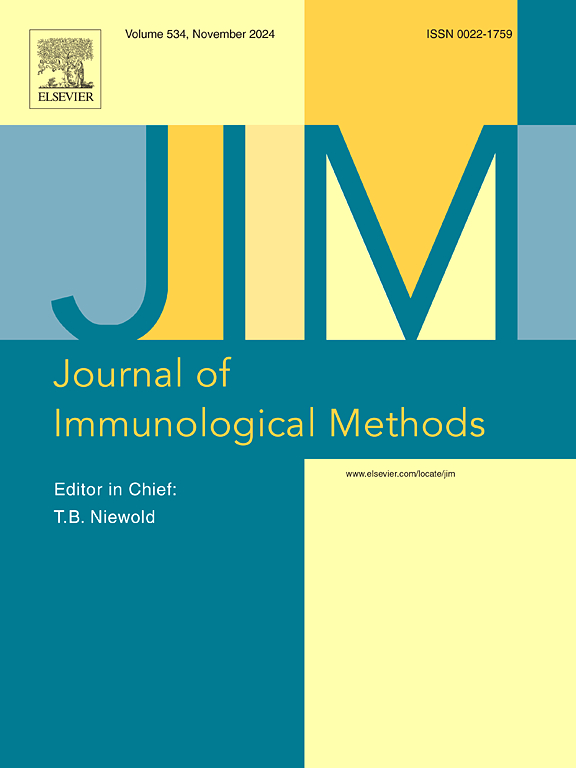Expression of bluetongue virus full-length VP7 protein in insect cells and its diagnostic utility for detection of antibodies to the virus infection
IF 1.6
4区 医学
Q4 BIOCHEMICAL RESEARCH METHODS
引用次数: 0
Abstract
Bluetongue (BT) is a vector-borne viral disease of multiple domestic and wild ruminants across the globe. The VP7 protein of bluetongue virus (BTV) is the major immune-dominant structural protein that is conserved across the BTV serotypes and therefore, targeted for the development of immuno-diagnostics for BT. In this study, full-length recombinant VP7 protein (rVP7) of BTV-1 was expressed in Trochoplusia ni derived insect cells (Tn5) using codon-optimized synthetic gene construct through baculovirus expression system. The seed stock of recombinant baculovirus was amplified to a high titre (>1 × 108 pfu/ml) at P2 and P3 in sf9 cells. The rVP7 was successfully produced and purified from infected Tn5 culture lysate for evaluation of the immuno-reactivity and its diagnostic potential. The purified protein showed strong reactivity in western blot analysis with the polyclonal immune serum produced against BTV core antigen in guinea pigs. An indirect ELISA (iELISA) was optimized by using the purified rVP7 for the detection of the group-specific antibodies to BTV in sheep and goats. The iELISA was found to be highly sensitive (98.9 %), specific (98.1 %), and reproducible (CV < 10 %) for detection of the antibodies to BTV in sheep and goat serum. The iELISA could detect the specific antibodies in naturally infected goat serum containing type-specific neutralizing antibodies to different BTV serotypes indicating the potential of the rVP7 for the development of the group-specific sero-diagnostics for BT.
蓝舌病病毒全长VP7蛋白在昆虫细胞中的表达及其在病毒感染抗体检测中的诊断价值
蓝舌病是一种在全球多种家养和野生反刍动物中传播的媒介传播的病毒性疾病。蓝舌病毒(BTV)的VP7蛋白是主要的免疫显性结构蛋白,在BTV血清型中具有保守性,因此可以用于BT的免疫诊断。本研究通过杆状病毒表达系统,利用密码子优化的合成基因构建,在ni Trochoplusia衍生的昆虫细胞(Tn5)中表达了BTV-1的全长重组VP7蛋白(rVP7)。重组杆状病毒种子库在sf9细胞P2和P3处扩增到高滴度(>1 × 108 pfu/ml)。从感染的Tn5培养液中成功制备并纯化了rVP7,以评估其免疫反应性及其诊断潜力。纯化后的蛋白与豚鼠抗BTV核心抗原的多克隆免疫血清具有较强的免疫反应性。用纯化的rVP7优化间接ELISA (iELISA)检测绵羊和山羊BTV群体特异性抗体。发现iELISA具有高灵敏度(98.9 %)、特异性(98.1 %)和重复性(CV)
本文章由计算机程序翻译,如有差异,请以英文原文为准。
求助全文
约1分钟内获得全文
求助全文
来源期刊
CiteScore
4.10
自引率
0.00%
发文量
120
审稿时长
3 months
期刊介绍:
The Journal of Immunological Methods is devoted to covering techniques for: (1) Quantitating and detecting antibodies and/or antigens. (2) Purifying immunoglobulins, lymphokines and other molecules of the immune system. (3) Isolating antigens and other substances important in immunological processes. (4) Labelling antigens and antibodies. (5) Localizing antigens and/or antibodies in tissues and cells. (6) Detecting, and fractionating immunocompetent cells. (7) Assaying for cellular immunity. (8) Documenting cell-cell interactions. (9) Initiating immunity and unresponsiveness. (10) Transplanting tissues. (11) Studying items closely related to immunity such as complement, reticuloendothelial system and others. (12) Molecular techniques for studying immune cells and their receptors. (13) Imaging of the immune system. (14) Methods for production or their fragments in eukaryotic and prokaryotic cells.
In addition the journal will publish articles on novel methods for analysing the organization, structure and expression of genes for immunologically important molecules such as immunoglobulins, T cell receptors and accessory molecules involved in antigen recognition, processing and presentation. Submitted full length manuscripts should describe new methods of broad applicability to immunology and not simply the application of an established method to a particular substance - although papers describing such applications may be considered for publication as a short Technical Note. Review articles will also be published by the Journal of Immunological Methods. In general these manuscripts are by solicitation however anyone interested in submitting a review can contact the Reviews Editor and provide an outline of the proposed review.

 求助内容:
求助内容: 应助结果提醒方式:
应助结果提醒方式:


